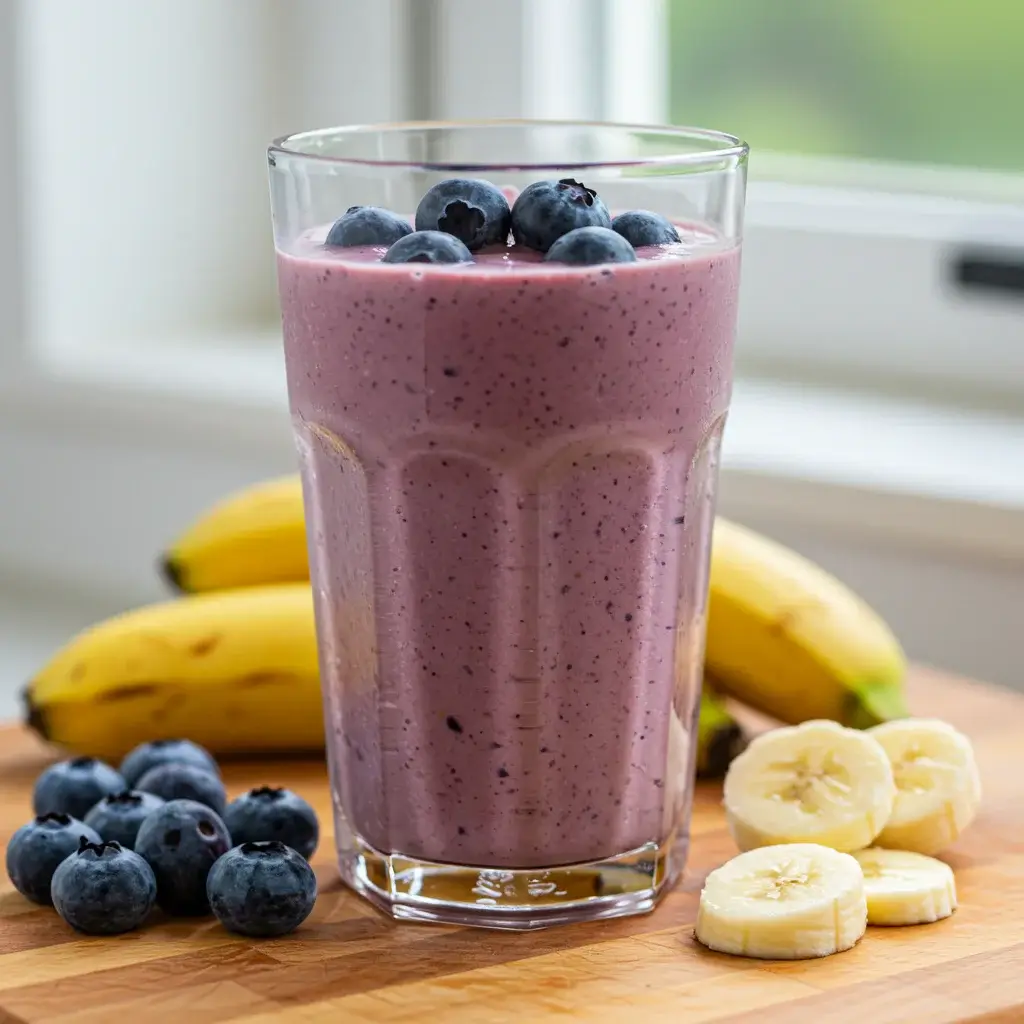Smoothies have become a staple in many health-conscious individuals’ diets, offering a quick, delicious way to pack a variety of nutrients into one meal. Among the myriad options, the Blueberry Protein Smoothie stands out for its delightful combination of taste and nutritional benefits. This article will guide you through preparing this smoothie, its health benefits, and answer any questions you might have about incorporating it into your diet.
Introduction
Smoothies are more than just a trendy drink; they are a convenient way to consume a variety of nutrients in one go. The Blueberry Protein Smoothie is not only tasty but also provides a nutritional boost that can aid in muscle recovery, keep you full, and provide energy throughout the day. Blueberries are known for their antioxidant properties, while the protein powder ensures you’re meeting your daily protein requirements, especially important for those with an active lifestyle.
Ingredients
To make this smoothie, you’ll need the following ingredients:
- 1 cup frozen blueberries: Rich in antioxidants, fiber, and vitamin C.
- 1 banana: Provides natural sweetness, potassium, and a creamy texture.
- 1 cup almond milk (or any milk of choice): A source of calcium and vitamin D.
- 1 scoop vanilla protein powder: Essential for muscle repair and growth.
- 1 tbsp honey or maple syrup (optional): Adds extra sweetness as needed.
Instructions
Creating this smoothie is a breeze and takes just a few minutes. Here’s how you can make your own Blueberry Protein Smoothie:
- Gather Your Ingredients: Ensure you have all the ingredients ready to go. This makes the blending process smooth and efficient.
- Blend the Ingredients: Add the frozen blueberries, banana, almond milk, vanilla protein powder, and optional honey or maple syrup into a blender.
- Blend Until Smooth: Start the blender on a low setting and gradually increase to high. Blend until the mixture is smooth and creamy.
- Taste and Adjust: Taste your smoothie and adjust sweetness if necessary by adding more honey or maple syrup.
- Serve: Pour the smoothie into a glass and enjoy immediately for the best taste and texture.
Nutrition Facts
Here’s a breakdown of the nutrition facts per serving of this Blueberry Protein Smoothie:
- Calories: ~250
- Protein: ~20g
- Carbohydrates: ~30g
- Fat: ~5g
This nutrient profile makes it a great option for a post-workout snack or even a quick breakfast.
How to Serve
The Blueberry Protein Smoothie is an incredibly versatile beverage that can be enjoyed in various contexts throughout the day. Its delicious flavor and nutrient-rich profile make it a popular choice for those looking to enhance their diet. Below are some detailed serving suggestions to help you maximize the benefits and enjoyment of this smoothie.
As a Breakfast
Starting your day with a Blueberry Protein Smoothie is a great way to kick off your morning with a burst of energy and essential nutrients. To create a more balanced breakfast, consider pairing your smoothie with a slice of whole-grain toast topped with avocado or nut butter. This combination provides:
- Complex Carbohydrates: The whole-grain toast offers fiber and sustained energy.
- Healthy Fats: Avocado or nut butter adds heart-healthy fats that keep you full longer.
- Protein Boost: If you use a protein-rich spread like almond butter, you further enhance the protein content of your meal.
For an added touch, sprinkle some chia seeds or flaxseeds on your toast for extra omega-3 fatty acids and fiber.
Post-Workout Recovery
After a rigorous workout, your body needs to replenish lost nutrients and support muscle recovery. The Blueberry Protein Smoothie is an excellent choice for post-exercise nutrition due to its rich protein content and antioxidant properties from the blueberries. To optimize recovery, consider the following:
- Timing: Aim to consume your smoothie within 30 minutes after your workout to maximize muscle recovery and glycogen replenishment.
- Additional Add-ins: Enhance the smoothie with ingredients like spinach or kale for extra vitamins and minerals, or add a scoop of Greek yogurt for an additional protein punch.
- Hydration: Consider blending the smoothie with coconut water instead of regular water or milk. Coconut water is rich in electrolytes, which can help rehydrate your body after sweating during your workout.
Snack Time
The Blueberry Protein Smoothie serves as a nutritious snack option between meals, helping to curb cravings and maintain energy levels. Here are some tips for making the most of this smoothie as a snack:
- Portion Control: Serve the smoothie in a smaller glass or container to avoid overindulging. A 6-8 ounce portion is typically sufficient to satisfy hunger without spoiling your appetite for the next meal.
- Pairing Suggestions: For a more filling snack, pair your smoothie with a small handful of nuts or a piece of fruit. This combination adds healthy fats and additional fiber, making it a more complete snack.
- Flavor Variations: Experiment with different flavors by adding a scoop of cocoa powder for a chocolate twist or a tablespoon of nut butter for added creaminess and flavor.
For an Extra Nutritional Boost
If you’re looking to elevate the nutrient profile of your Blueberry Protein Smoothie even further, consider incorporating the following ingredients:
- Superfoods: Add a tablespoon of spirulina or acai powder for an additional boost of antioxidants and nutrients.
- Fiber Enhancers: Mix in psyllium husk or oat bran to increase fiber content, which can help with digestion and keep you feeling full longer.
- Herbs and Spices: A pinch of cinnamon or ginger not only adds flavor but also comes with anti-inflammatory benefits. Additionally, fresh mint can provide a refreshing twist.
- Probiotics: Incorporating a scoop of probiotic powder or a serving of kefir can enhance gut health, making your smoothie not just tasty but also gut-friendly.
By utilizing these serving suggestions, you can make the Blueberry Protein Smoothie a versatile addition to your diet, suitable for breakfast, post-workout recovery, a snack, or an enhanced nutritional treat. Enjoy experimenting with different combinations to find your ideal balance of flavor and nutrition!h chia seeds, flaxseeds, or a handful of almonds.
Additional Tips
Crafting the ideal Blueberry Protein Smoothie is an art that can be perfected with a few thoughtful tips and tricks. Here’s a comprehensive guide to ensure that your smoothie is not just good but exceptional every time you blend it.
1. Use Frozen Fruit
Why Frozen?
Opting for frozen blueberries instead of fresh ones is key to achieving that perfect creamy texture. Frozen fruit not only chills the smoothie but also lends a thicker consistency without the dilution that ice can introduce. When ice melts, it can water down the flavor, compromising the rich taste of your blueberries and other ingredients. Additionally, frozen blueberries retain their nutritional value and are often picked at peak ripeness, ensuring you get the maximum antioxidant benefits.
How to Incorporate:
When preparing your smoothie, simply measure out the desired amount of frozen blueberries directly from the freezer. If you prefer using fresh blueberries, consider freezing them beforehand. Just wash and dry them, then spread them out on a baking sheet to freeze individually before transferring them to a bag. This method prevents them from clumping together, allowing you to use just the right amount for your smoothie.
2. Choose the Right Protein Powder
Types of Protein Powder:
The choice of protein powder can significantly influence both the flavor and nutritional profile of your smoothie. If you follow a vegan or plant-based diet, consider protein powders derived from sources like pea, hemp, or brown rice, which not only provide essential amino acids but also pair well with the fruity flavors. Whey protein, known for its high bioavailability and complete amino acid profile, is an excellent option for those who consume dairy.
Flavor Compatibility:
Ensure that the protein powder you select complements the natural sweetness of blueberries and bananas. For example, vanilla-flavored protein powders can enhance the overall flavor profile without overwhelming it, while chocolate protein powder can provide a richer taste that pairs beautifully with the fruity ingredients. Always check for added sugars in flavored powders, as these can lead to an overly sweet smoothie.
3. Balance Sweetness
The Sweet Spot:
Bananas offer a natural sweetness that can range from mildly sweet to very ripe, which means it’s essential to taste your smoothie before adding any additional sweeteners. If your banana is particularly ripe, you might find that your smoothie is sweet enough on its own.
Sweetener Alternatives:
If you find that you’d still like a touch more sweetness, consider using natural sweeteners like honey, maple syrup, or agave nectar. Start with a small amount—about half a teaspoon—and blend again. You can always add more if needed, but it’s challenging to correct an overly sweet smoothie. For those looking to minimize sugar intake, consider using a few drops of liquid stevia or monk fruit sweetener as a zero-calorie alternative.
4. Experiment with Add-ins
Boosting Nutrition:
Don’t hesitate to get creative with your smoothie by adding nutritious ingredients that can enhance both the taste and health benefits. Leafy greens like spinach or kale can be excellent additions. These greens are nutrient-dense and provide vitamins A, C, and K, as well as fiber, without overpowering the flavors of the fruit.
How to Add Greens:
Start with a small handful of spinach or kale—about one cup—before blending. The vibrant colors of the blueberries and banana will mask the green color, making it visually appealing. If you’re concerned about the taste, spinach is milder and is a great choice for beginners. You can also experiment with other add-ins like chia seeds for omega-3 fatty acids, or avocado for creaminess and healthy fats.
Other Flavor Enhancements:
Consider adding a scoop of nut butter (like almond or peanut butter) for a dose of healthy fats and protein, or a sprinkle of cinnamon for a warm, spiced flavor that complements the sweetness of the fruit. Each of these additions can elevate your smoothie to a new level, providing not just flavor but also nutritional benefits.
By following these detailed tips, you can ensure that your Blueberry Protein Smoothie is not only delicious but also tailored to your personal taste and dietary needs, making it a delightful and healthy addition to your daily routine.
FAQs
Can I use fresh blueberries instead of frozen? Absolutely! Fresh blueberries can be a delightful alternative to frozen ones in your smoothie. Using fresh blueberries can enhance the flavor profile, offering a burst of juiciness and a slightly different texture. However, since fresh blueberries are not as cold as their frozen counterparts, you might want to consider adding a few ice cubes or even a splash of cold water to ensure your smoothie remains chilled and refreshing. Additionally, keep in mind that fresh blueberries may yield a slightly thinner consistency compared to frozen blueberries, which can act as a natural thickener in your smoothie. If you prefer a creamier texture, you can blend in a frozen banana or a handful of ice along with the fresh blueberries.
What can I substitute for almond milk? If almond milk isn’t your preference or you have a nut allergy, there are numerous alternatives you can use to maintain the creaminess and flavor of your smoothie. Options include:
- Cow’s Milk: A classic choice that adds calcium and protein. Whole, skim, or 2% milk can all work well, depending on your taste.
- Soy Milk: A great source of protein, soy milk has a creamy texture and is an excellent non-dairy alternative.
- Oat Milk: Increasingly popular, oat milk has a naturally sweet flavor and creamy consistency, making it a wonderful option for smoothies.
- Coconut Milk: If you enjoy a tropical flair, coconut milk (either canned or carton) can add a rich, creamy texture and a hint of coconut flavor.
- Rice Milk: A lighter option that is naturally sweet but may not provide as much creaminess as some of the other alternatives.
- Hemp Milk: A nutritious option that is rich in omega-3 and omega-6 fatty acids, hemp milk has a unique flavor that can complement fruit smoothies well.
Is protein powder necessary? The addition of protein powder can significantly enhance the nutritional profile of your smoothie, providing a convenient source of protein that can help with muscle recovery, satiety, and overall nutritional balance. However, it is not strictly necessary. If you prefer not to use protein powder or are looking for a more natural source of protein, there are several alternatives you can consider:
- Greek Yogurt: This is an excellent substitute, as it is high in protein, creamy, and contributes to the overall thickness of the smoothie.
- Cottage Cheese: Another dairy option that is rich in protein and adds a creamy texture without overpowering the flavor.
- Nut Butters: Almond butter, peanut butter, or sunflower seed butter can add protein along with healthy fats, but be mindful of the added calories.
- Chia Seeds or Flaxseeds: These seeds are packed with protein and fiber, and they can help thicken your smoothie while adding nutritional benefits.
- Silken Tofu: A plant-based alternative that blends smoothly and adds protein without altering the flavor.
How long can I store the smoothie? For optimal flavor and nutritional benefits, it’s best to consume your smoothie immediately after blending. This ensures that you capture all the vitamins, minerals, and antioxidant properties of the fresh ingredients. However, if you find yourself with leftovers or want to prepare your smoothie in advance, you can store it in the refrigerator. Here are some tips for storing your smoothie:
- Airtight Container: Use a glass jar or a BPA-free plastic container with a tight-sealing lid to minimize exposure to air, which can cause oxidation and nutrient loss.
- Separation: You may notice some separation after storing, which is perfectly normal. Simply give your smoothie a good shake or stir before consuming to reintegrate the ingredients.
- Duration: While smoothies can be stored for up to 24 hours, they are best consumed within 12 hours to enjoy the freshest taste and texture. Beyond this timeframe, the quality may diminish, and the flavor can change.
Conclusion
The Blueberry Protein Smoothie is a fantastic addition to any diet, providing a delicious and nutritious way to fuel your body. With its simple ingredients and quick preparation time, it’s perfect for busy mornings or as a post-workout recovery drink. Whether you’re looking to boost your protein intake or simply enjoy a tasty treat, this smoothie has you covered. So, grab your blender and enjoy the refreshing, health-boosting benefits of the Blueberry Protein Smoothie today!
Print
Blueberry Protein Smoothie Recipe
Ingredients
- 1 cup frozen blueberries: Rich in antioxidants, fiber, and vitamin C.
- 1 banana: Provides natural sweetness, potassium, and a creamy texture.
- 1 cup almond milk (or any milk of choice): A source of calcium and vitamin D.
- 1 scoop vanilla protein powder: Essential for muscle repair and growth.
- 1 tbsp honey or maple syrup (optional): Adds extra sweetness as needed.
Instructions
- Gather Your Ingredients: Ensure you have all the ingredients ready to go. This makes the blending process smooth and efficient.
- Blend the Ingredients: Add the frozen blueberries, banana, almond milk, vanilla protein powder, and optional honey or maple syrup into a blender.
- Blend Until Smooth: Start the blender on a low setting and gradually increase to high. Blend until the mixture is smooth and creamy.
- Taste and Adjust: Taste your smoothie and adjust sweetness if necessary by adding more honey or maple syrup.
- Serve: Pour the smoothie into a glass and enjoy immediately for the best taste and texture.
Nutrition
- Serving Size: one normal portion
- Calories: 250
- Fat: 5g
- Carbohydrates: 30g
- Protein: 20g





